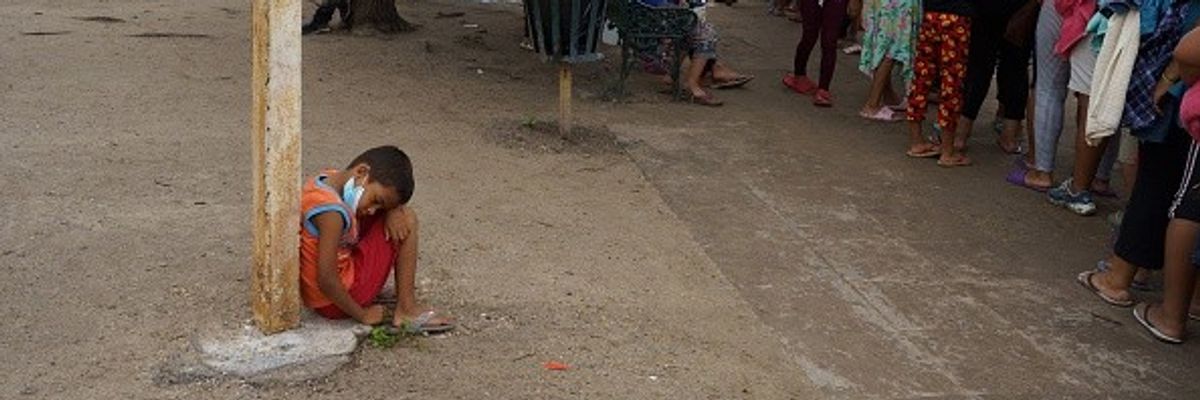The United Nation's children's welfare agency on Thursday called on member states to help address the root causes of the migration of children while ensuring that young people are kept safe when they do leave their home countries, as the number of children traveling on three major migration routes in Latin America and the Caribbean hit a new record.
According to the United Nations International Children's Emergency Fund (UNICEF), more than 60,000 children—including roughly 30,000 who were under the age of five—traveled through the perilous Darién jungle between Colombia and Panama in the first eight months of this year. An estimated 40,000 children made the journey in 2022 and about 29,000 crossed the jungle, where travelers must hike over steep mountain passes, walk through torrential downpours and cross fast-moving rivers—while also facing the risk of violence and exploitation.
A rising number of child refugees are also now migrating from other countries through South America and crossing through transit points in northern Central America and Mexico.
UNICEF estimates that about 25% of people currently making the journey through the Caribbean and Latin America are children, up from 19%. Across the globe, children make up about 13% of the migrant population.
Increasingly younger children are being forced to flee gang violence, extreme poverty, climate disasters, and other life-threatening problems in their home countries, with children under the age of 11 now making up more than 90% of all children traveling through key transit points.
"More and more children are on the move, of an increasingly young age, often alone and from diverse countries of origin, including from as far away as Africa and Asia," said Gary Conille, Latin America and Caribbean director for UNICEF. "When they cross several countries and sometimes the entire region, disease and injury, family separation, and abuse may plague their journeys and, even if they make it to their destination, their futures often remain at risk."
As more children have left their home countries in recent years, U.S. Customs and Border Protection (CBP) has reported a rise in the number of children crossing into the U.S., where tens of thousands are sent to government shelters even if they have relatives in the U.S. who can sponsor them. CBP recorded more than 83,000 children entering the country just in the first eight months of this year. Last year more than 155,000 arrived in the U.S., compared with 149,000 in 2021.
UNICEF's report was released two months after the World Meteorological Organization (WMO) reported that prolonged drought combined with extreme heat in recent summers have fueled "periods of record wildfires," while "tropical cyclones, heavy precipitation, and flooding events" have also threatened "coastal livelihoods, ecosystems, and economies" in Latin America.
The Social Panorama 2022 report on Latin America and the Caribbean released late last year by the Economic Commission for Latin America and the Caribbean also projected that 201 million people, or 32% of the region's population, live in poverty. More than 32%, or 82 million, live in extreme poverty, stemming largely from poor access to education.
UNICEF called on U.N. member states in the region to "ensure the rights, safety, and well-being of migrant and refugee children" while they are on the move and after they have arrived at their destination, and to ensure they have support in their home countries by:
- Mobilizing a regional approach to international protection and to address the child-specific root causes of migration;
- Investing in countries of origin to improve access to services, prevent and respond to violence, and create education and livelihood opportunities for vulnerable children, young people, and families, and support children who continue their residence in the country of origin while their parents have migrated;
- Expanding safe and regular migration pathways for children and families, including family reunification mechanisms, while upholding the right to territorial asylum, ensuring children and families can enter a state’s territory in order to apply for asylum and be able to remain there for the duration of asylum proceedings;
- Strengthening child-sensitive border and reception processes that are led by child protection authorities at the earliest possible stage, implement child-specific safeguards, preserve family unity including for children traveling with their non-parental caregivers, and ensure access to legal services; and
- Investing in strong national child protection systems to safeguard all children, including migrant and refugee children, from exploitation and violence.
UNICEF said $160.5 million is needed to meet the humanitarian needs of refugee children in Bolivia, Brazil, Chile, Colombia, Dominican Republic, Ecuador, Guyana, Peru, Trinidad and Tobago, and Uruguay, as well as $142.31 million for children traveling across Central America and Mexico.
As of August, the agency had received less than 20% and about 26%, respectively, of the needed funds.
-As of August 2023, UNICEF has received less than 20 per cent (approximately US$32.5m) of its funding requirements. UNICEF is also appealing for US$142.31 million for children and families on the migration route across Central America and Mexico in 2023. As of August, UNICEF has received just 26 per cent of these much-needed funds.
"The unprecedented scale of the child migration crisis in Latin America and the Caribbean urgently requires a stronger humanitarian response as well as the expansion of safe and regular migration pathways for children and families to help protect their rights and their futures," said Conille, "no matter where they are from."
